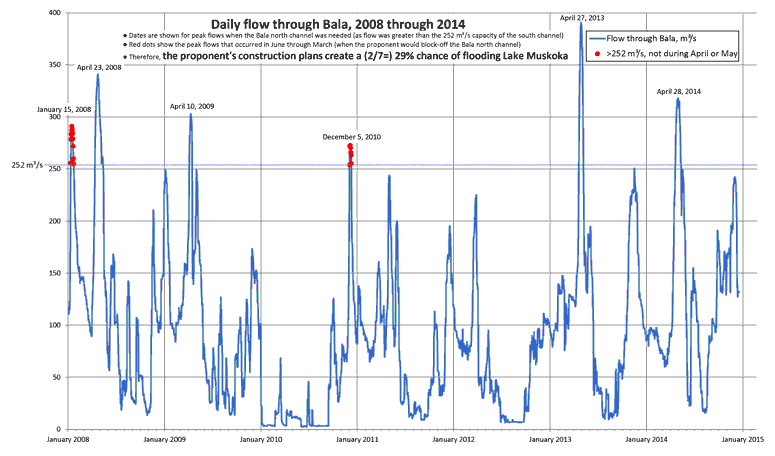The proponent’s construction plans show they would build a rock-fill cofferdam across the entire Bala north channel and this would be in place and block the flow of all water through the Bala north channel from June through March. Therefore, during this 10-month period, all water flow through Bala would need to go through the Bala south channel, which has a maximum capacity of 252 m³/s (cubic metres per second – for comparison, one cubic metre would fill three or four bathtubs).
The graph below (click on it for a larger view) shows the water flow through Bala each day for the last seven years. As expected, the peak flows are often in the spring, for example, on April 23, 2008 and April 10, 2009. But some years there are peak flows during the months of June through March, and these days are highlighted in red. These are days when solely the Bala south channel could not have handled all the flow through Bala, and flow through the Bala north channel was also required. But the proponent’s construction plans would have the Bala north channel blocked off during these months, so there would be flooding throughout Lake Muskoka.
That is, twice in the last seven years, the proponent’s construction plans would have caused flooding in Lake Muskoka. This is a (2/7=) 29% probability of flooding, which is the same result as our earlier analysis of the 45 years of flow data from 1966 through 2010.
The proponent claims that in such an emergency flooding situation they could and would quickly remove their cofferdam. But this claim is simply not credible, for example:
- As the high-flow event would likely be due to heavy rains, it would be dangerous to be operating the required construction equipment so close to the flooding waters.
- The necessary equipment and personnel may not be on-site when needed.
- Due to the blasting and excavation within inches of both the Bala north dam and the Muskoka Road 169 bridge over the Bala north channel, careful inspection of these structures would be required before it could be approved they would be ready to handle the force of the water. This inspection could not be done during a storm and would require more than a few days to arrange and analyse the results.
- Section 5.2.7.1 of the proponent’s 2009 Environmental Screening/Review report stated that the MNR does not allow in-water construction work from April 1 to July 15, so removing the cofferdam during this time period would be harmful to the fish habitat.
- The cofferdam would basically be tons of rocks, dirt, and plastic sheeting, and all of this would be washed down into the Moon River. This would be an environmental disaster as it would destroy the fish habitat.
- But a bigger environmental concern is that the construction site area which would be flooded may have construction equipment, gasoline containers, gasoline-powered electrical generators and many other items with fuel and lubricants that would be washed into and pollute Moon River – from which many people fish and get their drinking water.
- The proponent removing the upstream cofferdam would flood their construction site and this would;
- Destroy much of their completed work.
- Threaten the District’s Muskoka Road 169 bridge and the MNR’s Bala north dam.
- Delay the project by a year (as some of the construction stages can only be done at certain times of the year), and therefore cost millions of dollars.
The proponent would clearly not want this, so would likely instead; hope the rain stops soon, let Lake Muskoka flood until then, and see if private property owners try to sue them and then claim the flooding was an “Act of God” and a natural disaster. But the MNRF would have the responsibility to operate the dams and maintain water levels during the proposed construction, so the proponent may claim to have no liability even though their poor planning was the cause.
A big question is how insurance companies would treat such a situation.
- But the biggest concern of all is that the cofferdam would be needed to prevent water bypassing the Bala north dam, through the 60′-wide excavation required for the proposed generating station. That is, removing the cofferdam during some construction stages would result in the uncontrolled flow of much of Lake Muskoka into the Moon River. The water level in Lake Muskoka would drop by 10′ and the Moon River would be flooded like never before. This proponent with no assets, no operations, and no employees would not have insurance adequate to cover this. This would be a widespread financial and environmental disaster. So again, the proponent would not remove their cofferdam during such a construction stage.
Under the Navigation Protection Act, Transport Canada has a responsibility to assess the impacts of construction works in scheduled waterways, such as Lake Muskoka. So far their only action has been to secretly approve this proposed work despite this too-high risk of flooding.
Under the Lake and Rivers Improvement Act, the Ontario Ministry of Natural Resources and Forestry has a responsibility to assess the Plans and Specifications of this proposed project, which should include protecting the public from such risky plans by proponents. But the MNRF so far appears to accept the proponent’s unworkable emergency plans.
